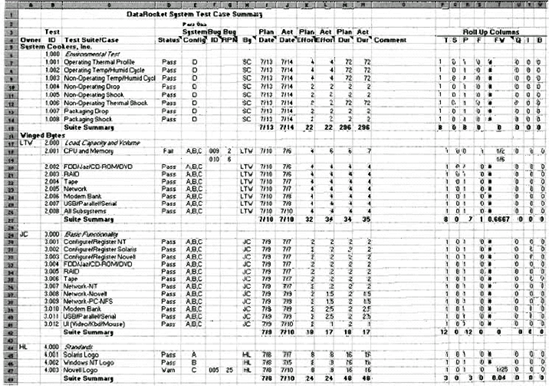5.2. Making Enhancements
Although the basic test tracking spreadsheet you've just seen is useful, you can certainly improve it to record and analyze even more information. Figure 5.5 and Figure 5.6 show an extended version of this tracking spreadsheet, with lots of useful enhancements that I've added over the years. The following sections describe how these data items help me manage my test projects. You might want to incorporate some of them (or come up with others on your own).
5.2.1. Assigning Identifiers and Testers to Test Suites and Cases
In addition to using short names for test suites and test cases, you can assign a Dewey decimal—style ID number to each. In a Test ID column, inserted to the left of the Test Suite/Case column, you can number each test suite, starting with 1.000, then 2.000, and so on. Each test case carries the suite number to the left of the decimal and its own sequential ID to the right of the decimal. For example, in the test case summary shown in Figure 5.1, the Load, Capacity, and Volume test suite would have the test ID 2.000, and the test ID for the CPU and Memory test case would be 2.001; likewise, the test ID for the Tape test case in the Basic Functionality test suite would be 3.003.
Figure 5.5. An extended test case summary worksheet.

When more than one person will be running tests, I find it useful to add an Owner column to the test case ...
Get Managing the Testing Process: Practical Tools and Techniques for Managing Hardware and Software Testing now with the O’Reilly learning platform.
O’Reilly members experience books, live events, courses curated by job role, and more from O’Reilly and nearly 200 top publishers.

